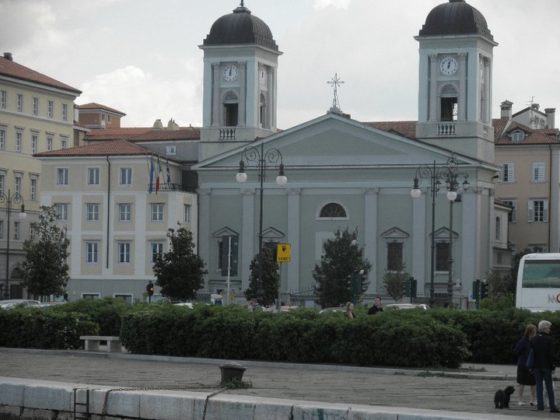Silent Partners to Empire: The Greeks and Serbs who helped build the Austrian and Russian Empires

Alexander Billinis
History favors the headlines rather than the fine print. Not unlike social media today, what is usually remembered are the posts and tweets rather than the long, complicated, but often far more rewarding reads. In the details, all too often, you find the realities, ones easily overlooked to the point when they are no longer the realities and we are left, instead, with the often rather empty headlines.
In the case of the southward expansion of the Austrian and Russian Empires against the heretofore dominant Ottomans, in the hundred years between the Ottomans’ defeat at the gates of Vienna in 1683 and the Russian annexation of the Crimea in 1783, the headlines are indeed few. Most students of history will know that the Russian, and particularly the Austrian, empires were multiethnic and that this would eventually figure prominently in the collapse of both. Few will know, however, that in both empires Greeks and Serbs formed key ethnic elements.
This is a story deserving to be told, for any number of reasons. First, because it is true, and it is an example of “silent minorities” forming the backbone of imperial success. Second, because this imperial experience transformed both the empires in question and fostered revolutionary activity in both the Greek and Serbian homelands. Finally, because the fate of these silent minorities is worth considering.
The Battle for Central Europe and the Black Sea basin was a long drawn out series of wars to remove the Ottomans from conquests won in the early 1500s, when the Ottoman Empire was at its height and all Europe trembled before them. Even though the Ottomans’ defeat at Vienna was a key turning point, and in the next decade and a half a vast territory would be liberated from Ottoman rule, the see-saw battles and destruction continued. Around the same period, the Russian state also sought to push back the Ottomans who commanded the entire Black Sea littoral, the key Crimean Peninsula, and much of the Ukrainian and Caucasian hinterlands. As in Central Europe, victories went back and forth, and territories changed hands, often resulting in scorched earth and depopulation.

The San Nicola Greek Orthodox Church, Trieste Waterfront, built 1792; PHOTO: VILMA BILLINIS
Eventually, first on the Austrian frontier and later on the newly Russian Black Sea coast, the borders stabilized as these European states consolidated their gains behind natural barriers, the Danube and Sava Rivers for the Austrians and the Black Sea coast and Caucasus Mountains for the Russians. Much of their new possessions were wastelands, ravaged by fire and sword for decades, with no production or economy. Neither Austria nor Russia were particularly wealthy states in comparison to the Atlantic countries of Europe.
Enter the “Silent Partners”
The Orthodox population of the Ottoman Empire chafed under Turkish rule and viewed the advance of Austria towards the Balkans favorably, though with a degree of skepticism. Austria was a Roman Catholic power and Catholics were hostile to Orthodoxy, as the Orthodox Greeks under Venetian rule could attest. As an Orthodox power, Russia held a more natural appeal to Greeks, Serbs, and the other Balkan Orthodox. For their part, the Russians and Austrians were only too glad to use the Balkan Orthodox populations for support in their campaigns against the Turks. This included deep Austrian incursions into the heart of Ottoman held Serbia, and an attempt in the Russo-Turkish war of 1770-1774 to open a second front in the Peloponnesus. Both attempts failed and resulted in horrific Ottoman revenge against the rebellious Orthodox, prompting many to quit the Ottoman Empire for the Russian and Austrian realms.
Since the Treaty of Passarowitz (Pozarevac) in 1717, Ottoman citizens could trade and establish themselves in the Austrian Empire. Tens of thousands of Greeks and Serbs answered the call, setting up extraordinarily strong merchant colonies in several Austrian cities, most notably the main Austrian port of Trieste, where Greeks and Serbs dominated shipping and commerce. Due to geographical proximity, the Serbs were by far the largest number of Orthodox immigrants, and they settled whole villages as farmers and soldiers, policing the Austro-Turkish frontier as loyal Habsburg soldiers for two centuries.
The Russians also heavily leaned on the Orthodox of the Ottoman Empire. Here the Greeks tended to dominate in terms of numbers. Thousands quit the Peloponnesus and other parts of Greece to settle the newly conquered Black Sea territories, bolstered in several waves (up to 1920) by Greeks from the Black Sea coast of Turkey. Bulgarians also settled heavily in parts of the newly liberated Russian territory (known then as Novorossiya “New Russia” and now part of the Ukraine), where Serbian farmers settled in the interior. The new port city of Odessa quickly boasted a large Greek shipping and merchant population, and as the Ukrainian chernozemlya (black soil) began to be plowed up, Greeks played a key role in the grain trade. It might almost be said that the export trade of Black Sea Russia was “subcontracted” to Greeks, who, whether subjects of the Tsar or not, had the right after the Treaty of Kucuk Kaynardji (1774) to fly the Russian flag.
Greeks and Serbs never forgot about their homeland, even as they were often phenomenally successful subjects of the Hapsburg and Romanov Empires. Though the Austrians were Catholic, they granted toleration to their Orthodox subjects, though they required that Orthodox Churches conform to Austrian baroque styles, which is why Serbian and Greek Orthodox churches in the former Austrian Empire, including in Serbia’s Vojvodina province, look remarkably Western in appearance. Greeks and Serbs fostered cultural and linguistic education in their communities, and actively endowed institutions back in their Ottoman homelands, which raised the level of cultural awareness and the desire for Greeks and Serbs to “rejoin Europe” and claim their place at the table. The first Greek newspaper was in Vienna, and it was from Austrian Trieste that Rhigas Pheraios, the first martyr of Greek (and Serbian) independence was to set out to fan the flames of revolution in the Balkans. A Greek betrayed him to the Austrian police, recalling the Greek saying that “Where there is a Thermopylae one will find an Ephialtes (traitor).” Without the financial, cultural, and moral support of the Austrian or Russian based diasporas, there would not have been successful revolutions in either Greece or Serbia.
When the time for action came, these diasporas were heavily involved in the conflict. The Secret Society dedicated to Greece’s liberation, the Philike Etairia, was founded in Odessa in 1814. The first salvoes of the conflict were fired in Romania, by Russo-Greek volunteers, many of them on a leave of absence from the Russian army. Serbians living on the other side of the Austrian frontier readily aided their brethren to the south, despite the official hostility of the Austrian (and the Russian) regimes for any revolutionary activity. Many Greeks and Serbs returned to the emergent states, some integrated into the local ruling class, yet others, the majority, stayed in the Diaspora. They remained dedicated to their Greek and Serbian heritage and fostered business links with the homeland when possible. Yet the slow pace of assimilation continued, particularly in the Russian Empire where they were among coreligionists. It is quite common to find Hungarians or Austrians with Greek and Serbian ancestors, and in Russia, large, cohesive Greek communities have remained to this day, though far more assimilated into the Southern Russian and Ukrainian populations. Greeks and Serbs always answered the call of their adopted countries.
What Remains
In the former Austria-Hungary, most of the Greek and Serbian communities have largely assimilated, though Vienna remains a huge Serbian Diaspora center, largely recent economic immigrants. A portion of the Serbian migration into the Austrian Empire was absorbed into Yugoslavia in 1918, but with the independence of Croatia in 1991 and the subsequent war, hundreds of thousands of Serbs were forced to flee the homes they inhabited for centuries, as soldiers and farmers defending and building the Hapsburg Empire. The northern Serbian province of Vojvodina remains as a legacy of this community, united with the Serbian motherland yet proud of their distinct culture, which includes an unusual tolerance for the 23 other nationalities resident in a province a bit smaller than Massachusetts. The vast swath of Serbian settlement in today’s Hungary has disappeared. According to a professor in Budapest’s Nikola Tesla High School, which remains one of the best Serbian high schools anywhere, the Hungarians actively forced assimilation on the Serbs over the past one hundred years, so that a community numbering 300,000 in 1918 is less than 3,000 today, even as there remain about 300,000 Hungarians in Serbia’s Vojvodina province. All over Hungary I have found empty Serbian Orthodox Churches, often ornate with large courtyards, testimony to a prosperous and proud community that helped make the empire possible.
In Russia, Ukraine, and Georgia, the situation was somewhat more complicated. The Serbian farmers in the Ukrainian interior quickly assimilated among coreligionists who spoke a similar language, with only a few place names to indicate any difference from their neighbors. For the Greeks, it was a different matter. Though the vast majority did assimilate into the large Ukrainian and Russian population, the density of their settlements, primarily on the coasts, with constant inflows of immigrants and refugees, and the advanced Greek maritime network meant that the Greeks remained both distinctive as a community and vital to the southern Russian economy. The community was bolsted by wave after wave of Pontic Greeks fleeing Turkish genocide. The Greeks also felt autochthonous there; Greeks had settled the Black Sea since classical times, including the Crimea. In spite of, or in Stalin’s bizarre logic, because of their key role, they were often sent to Central Asian exile during the Stalinist era, and others still faded into Soviet assimilation. By the 1980s, though there were still about one million recognizable Greeks in the Soviet Union, and no doubt there were millions more with some Greek ancestry. A good portion would then seek to return to Greece via the right of return Greece grants to those of Greek descent. My military unit when I served in the Greek Army was at least fifteen percent born in the ex-Soviet Union. In the 1990s there was some hope that the Greek presence, bolstered by the Greek Merchant Marine and a relative strong Greek economy, might be revived but by and large the region remains depressed and the old glories of the Greek maritime diaspora are just memories forgotten even by the Greeks.
This is not to suggest that there is a lack of academic work on these communities. There certainly is, and some of the best Greek, Serbian, and Russian historians have compiled excellent studies. Often enough though history is written for other historians, rather than for the public at large. The context is key and often it is missing, or misled. For me, both as a writer and as a historian (in training), the role that Greeks and Serbs played in the wider world is extremely important. Far too often history is headlines, and the textual details are forgotten, to the point where they cease to be details or history at all. To turn around the narrative requires us to know the textual details and to turn these into headlines. The history is there, it is our history, and it helped to make their history. The context—that is up to us.











0 comments